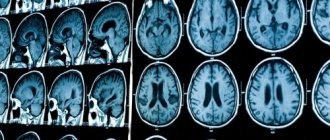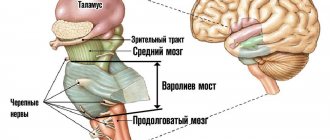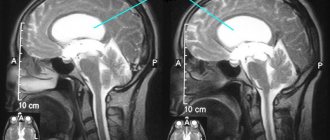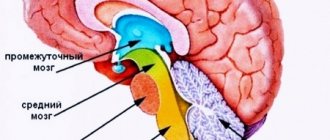From simple to complex
The baby’s nervous system develops in stages, becoming more and more complex every day.
Approximately on the 15th day after conception, the first nerve cells are formed, which will subsequently control the entire body. The development of the brain and spinal cord, as well as the entire nervous system of the child, begins with the formation of the neural tube. This is a strip of nerve cells that grows unevenly. In the head area it forms bubbles, which will then become the brain. In other parts of the body, the stripe bends - these are the future parts of the spinal cord. On the 22nd day after conception, the baby’s brain and spinal cord are not yet protected by anything3. The bones that form the skull and spine will appear later. But since the baby is still in your uterus and floating in the amniotic fluid, he is reliably protected from injuries and shocks. By the end of the first month, three brain vesicles can be seen in the baby’s head area: anterior, middle and posterior. In the sixth and seventh weeks, the anterior and posterior bubbles bifurcate and from three bubbles, five are obtained.
Subsequently, the anterior pair develops into the cerebral hemispheres and diencephalon (thalamus and hypothalamus). The middle cerebral vesicle will turn into the midbrain, to which nature has “entrusted” the performance of a large number of vital functions: it is responsible for vision, hearing, movement control, regulation of sleep and wakefulness cycles, orientation, protective and defensive reflexes, concentration, pain sensitivity, reproductive behavior and body temperature.
The hindbrain vesicle will become the rhomboid brain, the main functions of which are control of breathing and circulation, transmission of information from the spinal cord to the brain, coordination of movements, regulation of balance and muscle tone.
When the nervous system is formed, intrauterine development becomes a very delicate process, which is affected by any negative changes. Therefore, it is so important that you protect yourself from illness and stress, regularly undergo preventive examinations and listen to the advice of doctors. Visiting an obstetrician-gynecologist and following his recommendations is the key to ensuring that your baby develops properly and feels good from the first days of his intrauterine life4.
Some tips to improve brain performance
1. Adequate sleep is the key to vigor and improved cognitive abilities. It is recommended to sleep at least 7 hours. It is important that the brain is active unevenly throughout the day. Maximum activity occurs in two periods: two hours after waking up and during the day between 14 and 18 hours. If you feel drowsy at other times, you can drink a cup of coffee and rest for 15 minutes.
2. Nutrition. The best option is to eat little by little throughout the day without overloading your stomach. Digestion of food causes blood to flow to the stomach. By eating unevenly (either by absorbing a large amount of food or by starving), we get an undesirable result: either lethargy and drowsiness, when all our strength is spent on digestion, or loss of strength from insufficient nutrition of the brain with the substances necessary for its work.
Products that help improve brain performance:
- Water, about 2 liters per day.
- Omega-3 polyunsaturated fatty acids. Their source is fish oil, fatty sea fish; rapeseed, soybean and linseed oils; unroasted nuts (5-7 pieces per day).
- Complex carbohydrates. This food should form the basis of nutrition: it is it that gives us the lion's share of energy (up to 60%).
- Squirrels. Pay special attention to seafood and fish. But no one canceled poultry, legumes, nuts and meat either.
3.Training. Brain development depends on the number of neural connections and the speed at which the impulses generated by neurons are transmitted. Dementia threatens us when we lose most of our neurons, and vice versa: the larger the neural network, the better we are protected from it. To increase neural networks, training is necessary. In addition to new knowledge and hobby activities, games for brain development can be successfully used as brain training. For example, gaming simulators Bitreiniki serve this purpose. Games for brain development are exciting, take only 15 minutes a day, give you the opportunity to stimulate your achievements in tournaments, and observe statistics of success. They also involve rewards and encouragement, and this is also a good motivation, because who are adults if not big children?! Traveling, reading, creativity, learning languages and much more are also good. It is important that the activity teaches new things and brings pleasure.
4. Furnishings:
- Order on the table = order in the head.
- Access to fresh air is a necessity, not a whim.
- Silence and comfort are significant prerequisites for productive work.
5.Physical activity. It invigorates, relieves spiritual and physical tensions, lifts the mood, warms, improves metabolic processes and nourishes the brain.
6.Medicines – we will talk about them in more detail in the next article. But if you name one that calms and at the same time improves brain function, and is also available without a prescription, it is glycine.
What is your baby learning?
In the sixth and seventh weeks of pregnancy, in parallel with the brain and spinal cord, the child’s peripheral nervous system is formed: in it the largest cranial nerves can already be distinguished5. They are needed so that the baby’s brain quickly collects and processes information received from all parts of his body. By this time, other large organ systems begin to develop: the heart beats, the liver creates the first blood cells, and the kidneys grow. Also, the child’s arms and legs grow, eyes and ears form, the baby is already becoming like you. Every day he improves more and more, constantly learning new things.
In the second trimester of pregnancy, development continues: the baby already hears your voice and all external noises, and actively explores his body and the environment with his hands. He touches the umbilical cord, sucks his thumb, and develops the reflexes necessary for the future. He coordinates the movements of his limbs and trains daily. You can already feel his rhythmic kicks and thrusts from within. Also in the second trimester, the baby begins to open his eyes, now he may be frightened by bright light and shudder.
The second trimester also begins the process of myelination. This is “protective isolation” for each nerve, it improves its functioning so that your baby quickly learns new things. By the time of birth, the process of myelination is not completely completed; it continues during the first years of the child’s life. In the fifth month of pregnancy, the cerebral hemispheres are still smooth, but when your baby is born, they will already have convolutions and grooves.
Brain topography
Each part of the brain has its own functions. For example, information obtained through vision
is analyzed in the occipital region of the brain.
And the movement
is controlled by a fairly narrow strip of nervous tissue that stretches from the top of the head to the ear, like the earpiece of headphones.
Brain training
Is your memory failing? It’s not surprising, because she suffers without load in the same way as her muscles. Memory development exercises will help you - you can start doing them at any age.
At the same time, vision, hearing, movement, and all tactile sensations are controlled in a mirror way.
So, if a person has a stroke in the left hemisphere, the motor functions of the right side of the body are impaired. Next to the motor area is the area where tactile sensations
.
Therefore, often when the brain is damaged, a person simultaneously loses both the ability to move and the ability to feel. The perception of auditory information
occurs in the temporal region of the brain.
In right-handed people, the left temporal lobe is responsible for understanding words and expressing one's own thoughts. Right temporal lobe – helps to hear music and identify various noises. The area of the brain where the visual and auditory areas meet is responsible for the function of reading
- converting visual images into sounds.
Brain development: useful activities
Scientists believe that listening to classical music, viewing works of art, reading books, and your gentle voice have a positive effect on the formation of a child’s nervous system. Try to develop your baby’s nervous system every free minute. Read as much as possible, including out loud, so that you can be heard, admire the beautiful, enjoy pleasant melodies. Your positive emotions are extremely important for the development of your child’s brain and entire nervous system.
After the 30th week, when maternity leave begins, you can plan a program of cultural events: visiting exhibitions, museums or field trips. However, consult your doctor and find out which activities should be excluded from the list. So, prolonged standing, climbing steep stairs or being in noisy rooms should be avoided.
Article:
Modern pedagogy and psychology have a huge arsenal of scientific data, among which neurosciences occupy a special place. Despite the fact that scientists do not yet have a complete understanding of the process of human brain development, there is a sufficient number of facts, the understanding of which can greatly facilitate the life of parents and specialists working with children.
Brain development before and after birth. Why an expectant mother should eat well and avoid stress, while established parents should take their baby’s leisure time more seriously
Brain development begins even before the baby is born, and scientists consider the brains of people over twenty years of age to be fully mature. The most complex human organ undergoes multiple changes, is incredibly sensitive to external influences, and also largely depends on hereditary factors. How does the human brain develop?
What happens before birth?
The moment your baby took his first breath, his body has already done a lot of work and laid the foundation for the entire future functioning of the baby. Despite the fact that the size of his brain will increase another 4 times before it fully matures, the bulk of the neurons in it already exist, and its biochemistry has already been adjusted.
The fact that the brain that controls our feelings, thoughts and abilities is formed in the womb places great responsibility on pregnant women. We cannot underestimate the scientific evidence that lifestyle, quality of food and even the emotional state of a woman during pregnancy have a huge impact on the development of the baby.
For example, there is clear evidence that stress during pregnancy disrupts the formation of the structure of the limbic system tracts, which, in turn, is responsible for the emotional reactions of the future person. Scientists have been able to link the use of various medications, including the seemingly harmless paracetamol, with hyperactivity in children, and sugar abuse during pregnancy has affected the cognitive abilities of children.
Newborn brain. What is he like?
The uniqueness of man is that his brain is huge relative to the rest of the body, therefore, to pass through the birth canal, the child is born slightly underdeveloped, and the brain reaches almost full size (about 80%) by the age of three. You probably know about the fontanel, a soft area on the head of a newborn. It is this zone that is responsible for the possibility of a person being born naturally and for that very rapid growth of the child’s brain.
So, a child is born, and in front of him is a huge world and an incredibly complex society in which he needs to learn to live independently as quickly as possible. The baby’s brain is literally designed to learn huge amounts of information, because synapses (nerve cell connections that are the basis of all knowledge and skills) are formed much faster than in adults and even teenagers.
The principle of synapse formation is simple. The more often certain information reaches a child, the more significant the body considers it, the connection strengthens, and skill and memory in this area improves. This way, vital skills (for example, speech and walking) remain with the baby for life, and random events are forgotten with age. The same process is characteristic of the adult brain, but their speed of assimilation of information is significantly lower.
A child's brain craves new information and learns to sort it into important and unimportant categories. That is why it is important for preschoolers to have regular and extensive contact with a diverse environment. Thanks to the balance between various activities (creative and developmental activities, communication with elders and peers, playing alone, being in the city and in nature, outdoors and indoors, and so on), the baby’s harmonious development occurs, because his brain regularly encounters a variety of situations and learns to respond adequately to different stimuli and solve diverse problems.
How does the brain grow?
The structure of the brain changes not only due to synapses. Entire areas of the brain and nerve cells of a newborn are not yet fully formed by the time the baby is born.
Visual cortex
Everyone knows that babies do not acquire keen eyes right away, and when they are born they can barely distinguish the boundaries of objects and colors. This is because cells in the visual cortex develop and learn to recognize images in front of them within the first six months!
It is surprising that even with such an immature vision system (newborns hardly even know how to focus), they are already able to distinguish the most important image - the human face. It is during visual contact with their mother that newborns train their vision and learn to see the world.
The development of the visual organs and areas of the brain responsible for visual information begins with visual contact with the mother. Early development specialists recommend looking at and talking to the baby as much as possible, especially during breastfeeding, because with this simple action you stimulate the baby's development.
Cerebellum
Many people remember from their school biology course that the cerebellum is responsible for the development of movements, and is also involved in memory, attention, speech acquisition, and even the formation of emotions. It is easy to guess that the harmonious development of this most important area of the brain largely depends on the child’s sufficient physical activity. From rolling over and crawling to sports clubs and dance classes, moderate physical activity stimulates the active development of the cerebellum. To understand how necessary movement is for the well-being of a child, it should only be mentioned that the cerebellum increases three times in size only in the first year of a baby’s life.
The cerebellum, which is involved in a huge number of brain processes, develops only under conditions of adequate physical activity. That is why it is important for parents of infants to give their children the opportunity to move, crawl and grab objects around, certainly testing them.
Myelination of neurons
If we imagine that neurons are the wires of the body, then myelination is their high-quality insulation. Coating cell processes with a special substance (myelin) allows the nervous system to transmit signals faster and more accurately. It is because of the incomplete process of myelination that it is more difficult for infants to process information and quickly respond to changes in the environment. For the same reason, they cannot perform subtle and complex actions.
From simple to complex
Solving increasingly complex problems becomes within the capabilities of a young brain thanks to the completion of increasingly complex chains of neurons, as well as the configuration and automation of the joint work of these chains. The rule is simple: the more individual operations a task includes, the later it will become available to the brain. That is why babies first learn to move their legs, and only then can use walking to get to the right place or object.
How to create optimal conditions for the harmonious development of a child’s brain?
As you already understand, despite the role of heredity in the development of the nervous system of children, a well-organized environment is much more important. In this section, we would like to pay attention to the main characteristics of a truly developmental environment that has a positive effect on the harmonious development of the child’s brain from birth.
Social environment
The desire to be among other people is inherent in us at the level of instincts, so it is not surprising that for normal development a child simply needs contact with other people. Our brain has undergone many changes precisely thanks to the advent of culture (for example, humans have especially developed frontal lobes, which are responsible for arbitrariness and complex information processing), therefore, for its normal development, a child simply needs communication with his own kind. A wide range of acquaintances and the opportunity to communicate with adults and peers in various conditions stimulates the areas of the brain responsible for the development of speech, self-control and emotional intelligence.
Researchers studying the brains of people who were socially isolated as children have noted that even as adults, their brains react more strongly to stress, are more sensitive to criticism, and are less susceptible to conscious control.
Attending educational activities, evenings with family, joint walks with other families and any other forms of communication are necessary even for the youngest children, because they stimulate the development of the child’s brain, as a result of which his communication and cognitive abilities improve.
Balanced diet
It is important for parents to remember one obvious fact: being an organ of the human body, the brain needs a varied and balanced diet. Even the adult brain is highly dependent on the quality of nutrition, and for the child's brain, a healthy diet is critical. We are talking about both a sufficient amount of vitamins and minerals and a balance of proteins, fats and carbohydrates. Neurologists are currently actively studying the effects of various types of diets on children’s brain development, but there is already evidence of a connection between increased sugar consumption and cognitive impairment in children, as well as the harmful effects of obesity on the brain function of adolescents.
Many parents go to extremes and, instead of a varied diet, begin to feed their children whole handfuls of vitamin and mineral supplements. Remember that any nutritional supplements and medications should be given to children only after consultation with a doctor and based on test results. A healthy diet, including vegetables, cereals, herbs, animal and vegetable protein, vegetable and animal fats in moderation, as well as the maximum exclusion of unnatural additives and semi-finished products, is quite enough for a healthy diet.
Physical activity
We have already written that physical activity is critical for children’s health. Try to instill in children a love of movement from the first months of life, use gymnastics for babies, allow the baby to crawl and touch different objects, introduce him to different surfaces. A little later, feel free to include physical education sessions, walks in the fresh air, games in children’s playgrounds, dance classes, gymnastics and sports interesting for the baby into your daily routine. Try to be an example for your child and do not reduce your own physical activity!
New experiences are the key to health!
We have written many times that in order to feel stability, develop a sense of time and improve control, a fairly strict daily routine is important for children. However, it is important to understand that the content of the classes must change. Use different types of creative materials, visit different playgrounds and parks, go on visits, invite other families to your place, learn new songs and poems. New information stimulates the formation of connections in the brain: the more positive and varied experiences a child has at an early age, the easier it will be for him to cope with new tasks in adulthood.
In each new task, our brain looks for similarities with its past experience, in this it is similar to search engines on the Internet. Imagine that in childhood, each person develops his own database, and the quality of the search engine depends on its vastness. New experiences broaden a child’s horizons and make him more successful and adaptive at an older age.
Avoid traumatic situations
Undoubtedly, difficulties and disappointments are also necessary for the child, as are positive emotions, but only problems that the child is able to solve on his own or with the help of his parents do not traumatize his psyche. Agree, it’s one thing to catch a baby crying because the shoelaces don’t want to tie themselves, but it’s another thing to calm a child who has prematurely encountered violence, illness or family disadvantage.
Hundreds of studies have shown that the effects of childhood trauma affect entire areas of the brain, disrupting their connections with other areas and interfering with the normal process of processing information, leading to post-traumatic disorders, depression and other disorders.
conclusions
The human brain is the most complex organ of the body; it is not surprising that its development requires more than one year, and the quality of its functioning depends not only on genetic factors, but also on the characteristics of the environment. Understanding the principles of brain development by parents allows them to create an optimal environment for the child.
In what cases is it necessary to do an MRI?
Timely diagnosis will help identify abnormalities in the development of any brain structure, this will help avoid possible mental and physical developmental disorders in the baby in the future.
Also, this procedure may be prescribed by a doctor if your child has suffered a head injury or is involved in sports where injuries are possible (wrestling, boxing, extreme sports). In such cases, the consequences of a blow or concussion may not appear immediately, so a control procedure will help avoid possible complications later.
Make an appointment now!
Indications for diagnosis using a magnetic resonance imaging scanner may include the following symptoms:
- infectious diseases;
- periodic occurrence of convulsive syndrome;
- frequent dizziness or headaches;
- periodic fainting without apparent external causes;
- progressive hearing loss;
- noticeable blurred vision;
- changes in behavior;
- severely delayed development.
For such indications, your doctor may refer you for an examination to find out what an MRI of the child's brain shows, identify the cause of the symptoms, and prescribe appropriate treatment.









